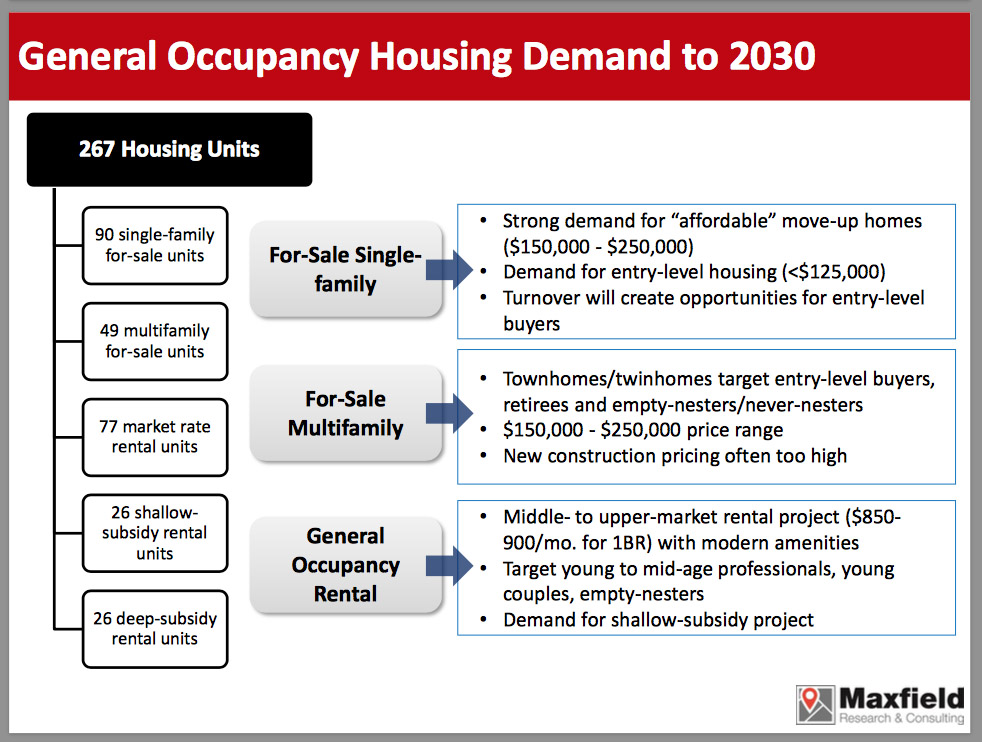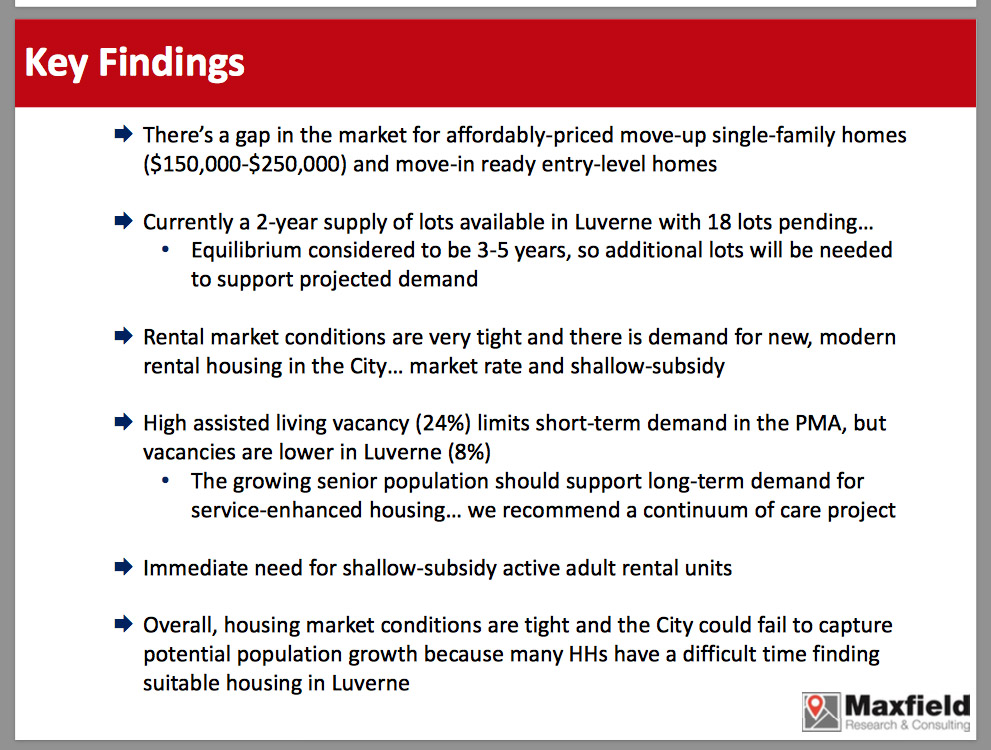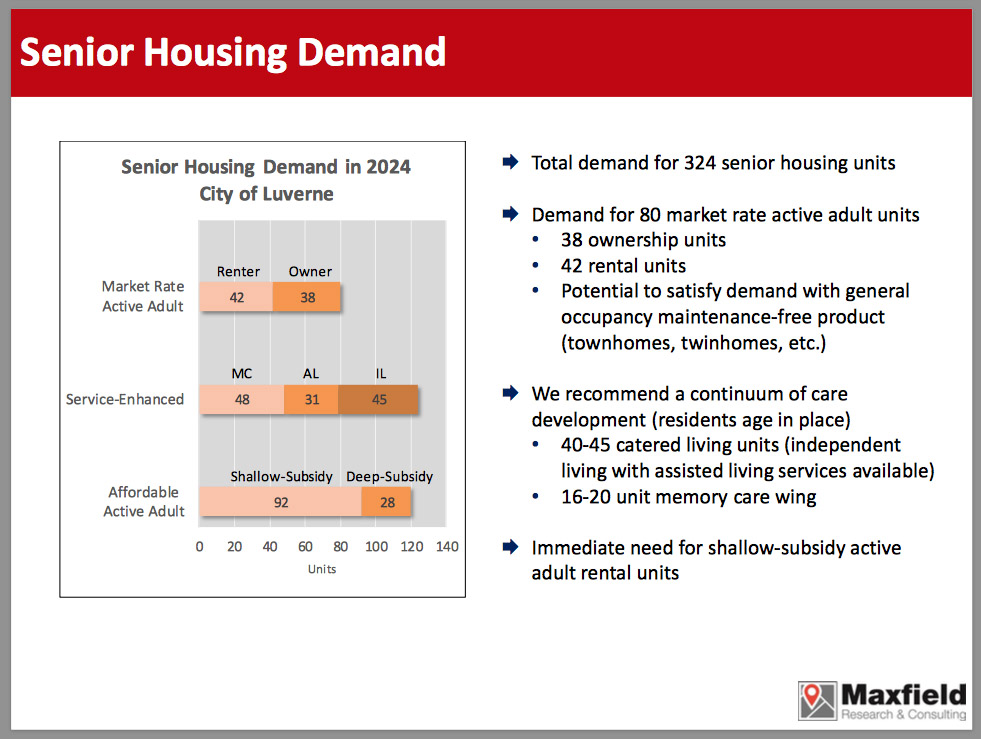 ,
,  ,
, 
Despite a recent flurry of housing development in Luverne, studies show demand continues to outpace supply.
New data shows a need for 267 more housing units through 2030, and more senior options could prompt turnover in existing mid-range homes that are in high demand.
Luverne city leaders requested an update to their 2016 study that showed a need for 360 new housing units over 10 years.
That information didn’t account for the 2018 announcement of Premium Iowa Pork bringing more than 200 jobs by mid-2020 and other growth on the horizon.
Results from the new 2019 study were compiled this fall, and Joe Hollman from Maxfield Research and Consulting reviewed the data at the November meeting of the Luverne Economic Development Authority.
Key findings from the study include:
•Modest population growth is expected, especially among senior and middle age groups.
•There’s a shift toward more renter households.
•Luverne is an importer of workers; roughly 1,653 workers commute into Luverne daily, while 1,016 commute out.
•Worker inflow can generate housing demand; roughly 25 percent (419 workers) commute from more than 50 miles away.
•Housing in Luverne is affordable relative to average wages, but mid-level homes are in high demand.
•A tight rental housing market is causing rental rates to increase and there’s pent-up demand for market rate apartments.
•Overall, housing market conditions are tight and the city of Luverne could fail to capture potential population growth if housing needs aren’t met.
Of the 267 recommended housing units by 2030 …
90 should be single-family for-sale homes.
49 should be multi-family for-sale units (town homes).
77 should be market-rate rental units (apartments).
26 should be “shallow-subsidy” rental units.
26 should be deep-subsidy rental units.
“Market rate” means the average wage earner can afford the full retail price. “Shallow subsidy” is defined as housing for residents who make too much money to qualify for subsidized housing, but they don’t earn enough to afford market rate housing.
The study found that local workers earning an average wage can afford rent of $968 per month, but the market average rental in Luverne is $605 per month.
“What I’m catching is that we have people who can afford to pay $900 per month but they don’t have to because there’s nothing worth $900 a month, and you can’t charge that because it’s 20 to 30 years old, with low services and amenities,” said EDA director Holly Sammons.
“We have people capable of paying that rate, but we don’t have the product to meet that demand.”
Meanwhile the study found the average worker could afford to purchase a home priced at $155,740, but the existing stock of homes in that $150,000 to $250,000 range are hard to find, with many sold before listing.
However, newly built homes are selling for an average of $300,000, which the average worker can’t afford.
The study suggests that making more townhomes available will help loosen the market for affordable homes, with the idea being that seniors seeking low-maintenance housing will sell their existing homes for townhomes.
But Mayor Pat Baustian noted that about half of the twin homes recently sold in town were purchased by people moving in from out of town.
“So that doesn’t really break loose a lot of the interim housing stock,” Baustian said.
That’s why the study recommends Luverne add 90 single-family for-sale homes and 49 townhomes by 2030.
Build it and they will come
Hollman said all of this matters in order for the community to grow.
“We’re projecting some population growth, but that’s only going to happen if there’s housing available for people to move into,” he said.
“In talking with some of the realtors, you are missing out on some potential growth. People wanting to move to Luverne end up in Worthington instead because they can’t find the house that they want here. … When the right houses open up, they move quickly and a lot of people just don’t have the patience to wait for the next right house to open up.”
The study found that 66 percent of the jobs in Luverne are filled by workers commuting into town — more than 1,600 of them. (About 1,000 residents commute out of Luverne for work.)
About a quarter of those commuters — more than 400 workers — come from more than 50 miles away.
City planners have speculated about how Luverne’s child care shortage also affects these trends, and they’re working on that issue on another front.
There’s a three-year supply of lots available in Luverne, including the 15 lots in the Uithoven Addition and three in the Reisch addition about to come on the market.
“As those are sold you’ll need to continue to develop additional lots,” Hollman said. “We need to give people alternatives to open up existing housing stock.”
Sammons noted that the newly developed housing additions allow for more multi-family lots than Manfred and Evergreen additions.
“Just because we have 30 lots for single family and one lot of multi-family available, you’re really not meeting that need to break open that $200,000 to $250,000 house on the market,” she said.
More senior housing options will help
Developing more senior-type housing will help, according to the study.
There’s a total demand for 324 senior housing units. Of them, 80 should be market rate active adult units — 38 ownership and 42 rental units.
The study also recommends “continuum of care” housing for residents to age in place. For example 40 to 45 units should be independent living with assisted services available, and 48 units for memory care.
Also, there’s an immediate need for shallow subsidy independent adult rental units for seniors who earn too much for subsidized housing but can’t afford market rate apartments.
Housing discussion turned briefly to the 27-unit apartment building planned for the former Sharkee’s lot, and Sammons said the study shows it’s needed, despite tru Shrimp’s change of plans.
“Everyone wondered if there was still a demand for that without tru Shrimp, and the answer is yes,” she said.
Valuable information
Sammons said the housing study was completed before tru Shrimp made its first announcements about coming to Luverne.
“It showed demand for market rate workforce housing. Tru Shrimp was just icing on the cake that further reduced risk on those numbers,” she said.
“But with tru Shrimp delaying their project, our housing study still stood, and we’ve had banks question that. So this is a very good confirmation this includes nothing about tru Shrimp or their numbers or their jobs.”
Baustian said the apartments will be needed for potential economic development on the horizon.
“Any further job creation is going to plus this report up even more,” he said.
“Our demographics, our wages, our product types available … there’s still a demand for a variety of housing.”
He also said the updated study is an important economic development tool.
“This is great information to verify the need,” Baustian said. “I know developers really appreciate the EDA doing this. It’s bank-worthy material that’s been verified and researched and is available when developers need to go to lenders.”
More information about the study’s findings can be found on the city’s website, cityofluverne.org. Search under the “business” tab, then “economic development,” and scroll down to “studies and reports” to find the “Luverne comprehensive housing study summary.”
Lopau sells acreage to city, now experiences housing demand
Lynn Lopau is selling her farm to the city and looking for another place to live.
The transition offers a unique perspective on Luverne’s housing shortage and the city’s efforts to meet demand.
After her husband, Merlyn, died four years ago, Lopau began considering a move.
Their children were grown and she no longer boarded horses on the 10 acres that include a house, garage, barn and outbuildings.
“I decided it’s too much house for me,” Lopau said. “There’s a lot to do here with mowing and snow removal — especially this year.”
She said she enjoys the solitude on her acreage and hasn’t been in a hurry to move, which is good in a local housing market that offers few options for someone in her position.
“There’s absolutely nothing for sale,” she said. “And I’ve heard that homes are sold before they’re even listed.”
Even though she’s downsizing, Lopau said she’s accustomed to spacious living, so an apartment isn’t on her list and neither is a townhome for similar reasons.
Since building a new home isn’t in her budget, she’s hoping a newer single-family home hits the market with the amenities she’s looking for.
‘They approached me,
and I was ready’
Meanwhile, Luverne city officials approached her about selling the farm for a housing development.
“John is a friend of mine, and it was very casual the way it came up,” Lopau said about City Administrator John Call. “I stopped in to see him about something, and he asked if I’d be interested in selling.”
After a series of health complications over the past 18 months, Lopau said she’s more ready than ever to leave the farm responsibilities behind. “I’m having to pay someone to do all the work,” she said. “I told John I’d think about it … but I was ready.”
In October the final papers were drawn up for the purchase agreement, and the city put down earnest money to hold the property until closing in August 2020.
Lopau said she hopes that will be enough time to prepare for a sale in the spring and find a place to move to.
And she’ll also use that time to reflect on memories.
“Merlyn and I were married 52 years. … I was 29 when we moved here in 1972,” she said. “We made a lot of improvements to the property and the house, a little at a time, over the years.”
She said Merlyn’s ashes are scattered in the barn and around the farm, and she said it pleases her that ground will provide future housing opportunities for the community.
“I think this is going to be wonderful. I think Merlyn would have like it,” she said.
“It will be great for Luverne as a whole. I love the thought of young people moving to town and bringing children to school.”
She said she’s also pleased that the house, garage and two acres will be sold as a single property.
“It’s hard enough to think of the barn coming down, and I’m glad I won’t be living there to watch that happen,” she said. “But it would have broke my heart to watch the house torn down.”
Dirt work to begin after 2021
The city is paying $475,000 for the house, garage and two acres, which will be resold as a single lot. The city paid $186,000 for the eight remaining acres, including the barn and outbuildings, which will be torn down.
According to City Council discussion, the closing date could be flexible, depending on Lopau’s needs, and dirt work won’t start until 2021 or later, depending on progress of current subdivisions under construction.
The subdivision will be platted for a mix of twin homes and single-family houses, which is what Luverne most needs, according to the latest housing study.


